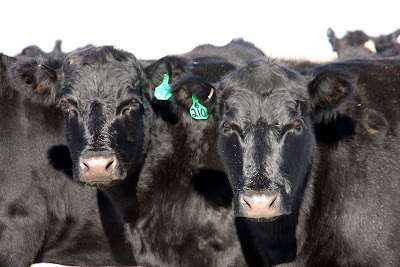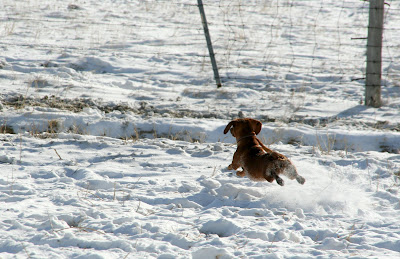Here are some images from my February 19th and 20th trip home. It was a cold, foggy and snowy weekend, which made for lots of feeding and some great pictures! Have a great Monday!




























 My dad uses green, 3-star (that's the size) Y-Tex tags. They come in bunches of 25, in clear bags, as can be seen on the left. Also included are 25 buttons, which are poked through the animal's ear to secure the ear tag in place. They work a lot like earrings do in humans, and giving a cow an ear tag is done the same way a human's ear is pierced, just with bigger equipment.
My dad uses green, 3-star (that's the size) Y-Tex tags. They come in bunches of 25, in clear bags, as can be seen on the left. Also included are 25 buttons, which are poked through the animal's ear to secure the ear tag in place. They work a lot like earrings do in humans, and giving a cow an ear tag is done the same way a human's ear is pierced, just with bigger equipment. We write on our own ear tags, and use a very durable ink. It's important you don't get any of this ink on your mother's/wife's/sisters table, as it will likely be there forever, and she won't be happy.
We write on our own ear tags, and use a very durable ink. It's important you don't get any of this ink on your mother's/wife's/sisters table, as it will likely be there forever, and she won't be happy. This is one of my jobs sometimes, and I'm not the best at it. You want to write big, clear, nice numbers on the tags so they are easy to read once in the cow's ear. The bigger and clearer the number, the better. Sometimes you have to read an ear tag in less than ideal conditions, and it needs to be legible.
This is one of my jobs sometimes, and I'm not the best at it. You want to write big, clear, nice numbers on the tags so they are easy to read once in the cow's ear. The bigger and clearer the number, the better. Sometimes you have to read an ear tag in less than ideal conditions, and it needs to be legible. Here are the first 25 tags, plus a couple for my brother, sister and I's heifers. My tags are pink, a color my dad picked because from a distance its easily distinguishable from green. Kyle's are the blue tags and Holly's are yellow. All of Holly's tags say Holly, then a number. So that tag reads 1 over Holly1. She insists on her name being on each tag.
Here are the first 25 tags, plus a couple for my brother, sister and I's heifers. My tags are pink, a color my dad picked because from a distance its easily distinguishable from green. Kyle's are the blue tags and Holly's are yellow. All of Holly's tags say Holly, then a number. So that tag reads 1 over Holly1. She insists on her name being on each tag. This is the ear tagger, aka big ear piercing gun. You don't want to lose this, and you want a spare in case you do lose this. Calving season is a time of almost constant sleep deprivation, and something like losing the last set of ear taggers could send a tired parent, sibling or spouse over the edge.
This is the ear tagger, aka big ear piercing gun. You don't want to lose this, and you want a spare in case you do lose this. Calving season is a time of almost constant sleep deprivation, and something like losing the last set of ear taggers could send a tired parent, sibling or spouse over the edge. The tag and button are secured like so. When you squeeze the gun it pushes the sharp-pointed button through the ear, and through the visible hole of the tag. The design prevents the button from coming back out, and the tag is secure.
The tag and button are secured like so. When you squeeze the gun it pushes the sharp-pointed button through the ear, and through the visible hole of the tag. The design prevents the button from coming back out, and the tag is secure. Another view. Cattle can be tagged at any stage in life, but lots of people tag calves as soon as they're born, and record their tag number, their sex, and their mother's tag number in a book. Some producers record additional information as well. Some of this information can be quite personal and colorful to the situation at hand, and is designed to help remember notable things about the cow, calf, or both. It may also note if any calving related issues occurred.
Another view. Cattle can be tagged at any stage in life, but lots of people tag calves as soon as they're born, and record their tag number, their sex, and their mother's tag number in a book. Some producers record additional information as well. Some of this information can be quite personal and colorful to the situation at hand, and is designed to help remember notable things about the cow, calf, or both. It may also note if any calving related issues occurred. Most people also put every ear tag in the same ear, every year. We switched years, sometime between 2004 and 2006 based on these cows, to accommodate our feeders chute setup. When feeding we would also put RFID tags in our steers, and sometimes our heifers, and we made sure those were on the side of his chute with the wand to record them.
Most people also put every ear tag in the same ear, every year. We switched years, sometime between 2004 and 2006 based on these cows, to accommodate our feeders chute setup. When feeding we would also put RFID tags in our steers, and sometimes our heifers, and we made sure those were on the side of his chute with the wand to record them.
 My dogs are cheap entertainment. One prime example of this is Pearl's obsession with chasing birds. She is all about it, regardless of weather, geographical or physical obstacles.
My dogs are cheap entertainment. One prime example of this is Pearl's obsession with chasing birds. She is all about it, regardless of weather, geographical or physical obstacles. See the little elusive buggers out in front of her?
See the little elusive buggers out in front of her? You will see her go streaking across the yard, first one way, then the other.
You will see her go streaking across the yard, first one way, then the other. After each burst of chase, she will pause, and listen for where the sneaky birds are located.
After each burst of chase, she will pause, and listen for where the sneaky birds are located. Then off she goes again, full force.
Then off she goes again, full force. Kyle says it's like watching a slinky stretch and contract.
Kyle says it's like watching a slinky stretch and contract. 
 It's a very serious thing for her.
It's a very serious thing for her.
 Here are our replacement heifers prior to getting their new tags and tattoos.
Here are our replacement heifers prior to getting their new tags and tattoos. Here is the vet filling his syringe with the vaccine.
Here is the vet filling his syringe with the vaccine. And here are the individually numbered tags. They are in the shape of a V, and the bottom of the side you can see here is a point that fits into a small hole on the other end. They're easy to put in, and have a very high retention rate.
And here are the individually numbered tags. They are in the shape of a V, and the bottom of the side you can see here is a point that fits into a small hole on the other end. They're easy to put in, and have a very high retention rate. Here is the tattoo gun. The little points create a specific number sequence. While I'm not positive on this, I believe it lists the month and year she was vaccinated, and possibly more numbers indicating the producers location. For example, it might list the county number (14 in our case) within Wyoming that the herd is located in.
Here is the tattoo gun. The little points create a specific number sequence. While I'm not positive on this, I believe it lists the month and year she was vaccinated, and possibly more numbers indicating the producers location. For example, it might list the county number (14 in our case) within Wyoming that the herd is located in. Here's the setup. No changes from a couple days ago, just more snow. My mom also weighed each of the heifers while she was in the chute so we have her growth information on file.
Here's the setup. No changes from a couple days ago, just more snow. My mom also weighed each of the heifers while she was in the chute so we have her growth information on file. One a heifer is caught, the first thing the vet does is give her a shot.
One a heifer is caught, the first thing the vet does is give her a shot. Then someone, my dad in this case, mugs (holds her head off to the side) the heifer, so the vet can give her the tattoo and tag.
Then someone, my dad in this case, mugs (holds her head off to the side) the heifer, so the vet can give her the tattoo and tag. Here is the tagger (out of focus) Note the V-shape. When he squeezes it, it folds the tag over and pokes the pointy end through the hole on the opposite.
Here is the tagger (out of focus) Note the V-shape. When he squeezes it, it folds the tag over and pokes the pointy end through the hole on the opposite. First the vet rubs the inside of the heifer's right ear clean with his glove. Then he rubs a generous supply of green paint over the area with his toothbrush.
First the vet rubs the inside of the heifer's right ear clean with his glove. Then he rubs a generous supply of green paint over the area with his toothbrush. Next the tattoo tool is aligned...
Next the tattoo tool is aligned... And squeezed. Following this step more green paint is rubbed over the tattoo.
And squeezed. Following this step more green paint is rubbed over the tattoo. Then the bright orange Brucellosis tag is put into place. It's put in the top of the ear because it's much less likely to be lost when the cow is rubbing on stuff, eating out of feeders, or doing any number of other things cows do, when in that location.
Then the bright orange Brucellosis tag is put into place. It's put in the top of the ear because it's much less likely to be lost when the cow is rubbing on stuff, eating out of feeders, or doing any number of other things cows do, when in that location. Then the heifer is released, and rejoins the rest of the bunch.
Then the heifer is released, and rejoins the rest of the bunch. Despite a green ear and an orange tag that may be rubbed to silver by the time she's old, the heifers are fine and ready to be fed.
Despite a green ear and an orange tag that may be rubbed to silver by the time she's old, the heifers are fine and ready to be fed. While it's hard to see in this picture, the Brucellosis tags really show up in person.
While it's hard to see in this picture, the Brucellosis tags really show up in person.